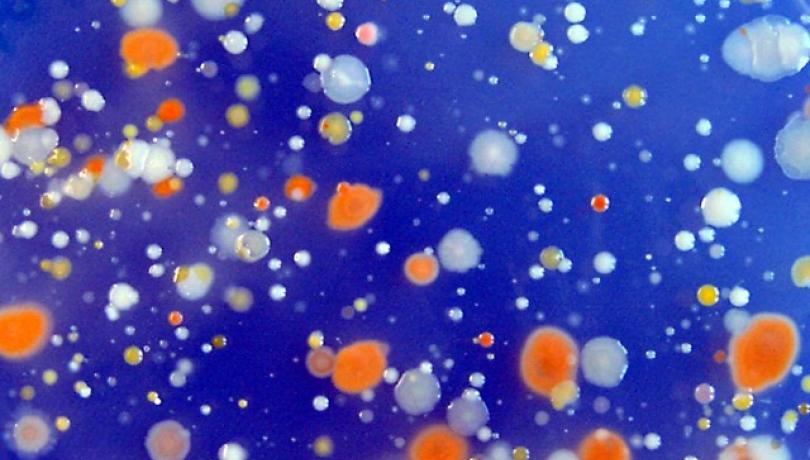Marine bacteria that capture light and transform it into biochemical energy are not a rarity, as previously thought. A work published this week in the journal Science Advances, with the participation of the Institute of Marine Sciences (ICM-CSIC), shows that sunlight, the main source of energy sustaining marine ecosystems, is mainly captured by bacteria, and not by algae and cyanobacteria (also called blue-green algae), as previously thought.

Marine bacteria that capture light and transform it into biochemical energy are not a rarity, as previously thought. A work published this week in the journal Science Advances, with the participation of the Institute of Marine Sciences (ICM-CSIC), shows that sunlight, the main source of energy sustaining marine ecosystems, is mainly captured by bacteria, and not by algae and cyanobacteria (also called blue-green algae), as previously thought.
The work is led by Laura Gómez Consarnau, who was a Marie Curie researcher at the ICM-CSIC when she did the work and currently works at the Center for Scientific Research and Higher Education in Ensenada (Mexico) and at the University of Southern California (USA).
Heterotrophic bacteria normally feed by degrading organic matter. But in the sea and other aquatic systems, some of them can perform a type of 'photosynthesis' thanks to two pigments, proteorhodopsin and bacteriochlorophyll. These pigments transform light into biochemical energy, just as chlorophyll does in algae and plants.
Until now, it was not possible to quantify the contribution these three pigments (chlorophyll, bacteriochlorophyll and proteorhodopsin) in the oceans' solar energy uptake. This research embarked on the Sarmiento de Gamboa ship to answer this question by studying the Eastern Mediterranean, one of the poorest seas in nutrients in the world, and comparing it with the Western Mediterranean and the Atlantic.
Thanks to their own method, they have quantified the retinal (the light-capturing molecule of the proteorhodopsin) in samples from the three seas. In addition to quantifying all pigments, scientists have calculated their geographical distribution and the amount of energy captured by each of the pigments.
The results reveal that, although bacteriochlorophyll contributes little to the entry of energy into the sea, proteorhodopsin captures approximately the same amount as chlorophyll and, sometimes, much more. Although there is less proteorhodopsin in the sea than chlorophyll, a single retinal molecule is sufficient, while many chlorophyll molecules are needed to create an effective photosynthetic energy collection system. “To have a functional photosystem, about 300 chlorophyll molecules are needed, while with the proteorhodopsins, only one retinal molecule is sufficient,” adds Laura Gómez Consarnau. Hence, they can capture much more energy, up to double.
Breaking the traditional paradigm
These results breaks the tradicional belief that almost all of the sunlight in marine ecosystems is captured by cyanobacteria, microalgae and algae thanks to chlorophyll. It also reveals that sunlight is an essential energy source for the survival of bacterial communities in waters where organic nutrients are scarce.
“We had already seen that proteorhodopsin allowed heterotrophic bacteria to survive without organic matter and take energy from light, but now we have shown that this process is widespread and very important in the sea", says Laura Gómez-Consarnau, main author of the study.
Josep M Gasol, CSIC research professor at the Institute of Marine Sciences and co-author, explains: “The number of things we still don't know about the sea is surprising. We will probably have to change the textbooks that put an arrow that goes from the sun to the phytoplankton and add a second one, which points towards the bacteria. ”
Bacteria with "hybrid" metabolism
The study sheds new light on the organisms at the marine trophic chain base that support many marine organisms. Proteorhodopsin bacteria have a hybrid metabolism: they can degrade organic matter, as most bacteria do, but they can also capture energy from the sun. For comparison, Josep M. Gasol compares them to hybrid cars that use both gasoline and electricity to move around.
In environments with scarce organic matter, the capture of sun energy allows them to survive, grow and generate biomass. The work suggests that in the seas with less nutrients, such as the Eastern Mediterranean, the entry of energy by this route is superior to that of normal photosynthesis.
In the work, in addition to CSIC researchers, teams from the University of Las Palmas de Gran Canaria, from the United Kingdom, from the USA also participate. and from Australia.
Source: Laura Gómez-Consarnau, John A. Raven, Naomi M. Levine, Lynda S. Cutter, Deli Wang, Brian Seegers, Javier Arístegui, Jed A. Fuhrman, Josep M. Gasol, Sergio A. Sañudo-Wilhelmy. Microbial rhodopsins are major contributors to the solar energy captured in the sea. Science advances. DOI: 10.1126/sciadv.aaw8855
Press release: CSIC local office in Catalunya